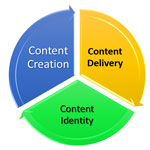The subscription revenue model is one of online content publishers’ most popular revenue models.
History of the Subscription Business Model and Recurring Revenue
The subscription-based revenue model is not new for content publishers.
As John Warrillow mentions in his book, The Automatic Customer, about five centuries ago, the European map publishers were inviting their customers to subscribe to the future versions of the maps. This offer was reasonable because, from time to time, new lands were discovered or conquered around the globe.
Newspapers, cable TVs, and many other media and communication businesses are more recent examples of the content creators employing this model, even before the birth of the internet.
However, with the boom of the content economy, content businesses became one of the leading examples of generating revenue through the subscription model.
In their book, “The Network Imperative,” Barry Libert and his colleagues have listed The Ten Principles for Creating Value. There they referred to “moving from transaction-revenue to the subscription revenue” as the sixth element of the list.
Although many points in this article apply to various subscription businesses, my concentration would be mainly on the content creators and how they use this revenue model.
Definition of the Subscription Revenue Model
There are many different definitions of the subscription business. Most of them address the same features with different wordings.
A subscription website is a site that collects a recurring payment from customers in exchange for recurring product replenishment or ongoing service.
Subscription fees are one of the major revenue models in which customers pay a fixed amount, usually monthly, to get some type of service. An example would be the fee you pay to an Internet access provider (fixed monthly payments).
Turban, Electronic Commerce – A managerial and social perspective
Alternatives to Subscription Revenue Model
- One-time selling
- Pay-as-you-go
- Perpetual License
Hybrid Models: Combining One-time Selling with Recurring Revenue Model
Although I have called the above options as alternatives, it’s also possible to include them as a complementary element in your selling proposition.
Outside of the content industry, you can find such hybrid models in many e-shops and online retailers such as Amazon.
Amazon offers a subscription option called Subscribe & Save on the product categories with recurring orders. The Amazon model provides free shipping and up to 15% discount on selected categories of products (Amazon’s Prime service is just another subscription offer, more similar to the classic style of subscription-based systems).
However, in the content industry, the hybrid model is not as popular as in e-tailing.
There are many content businesses with one-time purchase offers (e.g., a video file or an ebook), while some others prefer to sell subscription services. Again Amazon is a great use case of the hybrid revenue model with its Audible business. There you can experience a well-elaborated content revenue model utilizing the advantages of both types of revenue models.
Different Types of the Subscription Business Models
John Warrillow, in his book “Automtic Customer,” has listed nine different types of subscription business models:
- The Membership Website Model
- The All-You-Can-Eat Library Model
- The Private Club Model
- The Front-of-the-Line Model
- The Consumables Model
- The Surprise Box Model
- The Simplifier Model
- The Network Model
- The Peace-of-Mind Model
Some Examples of Using Subscription Revenue Model
- Universities and MOOCs
- Online Libraries
- Journals
- News Sources
- Music Streaming (e.g., Spotify, iTunes, Deezer)
Advantages of the Subscription Revenue Model
- A better opportunity for developing and deepening customer relationships (relationships tend to be longer)
- Lower barrier to entry (because of the lower price)
- The potential for reduction of customer acquisition costs
- Steady flow of revenue and more manageable cash flow (predictability of revenue)
- The possibility of providing customized services and creating personalized experiences
Disadvantages of the Subscription Revenue Model
Although the subscription model looks very attractive (it seems like sitting idle and just counting transactions), it has serious challenges. Here I’ve listed a few of them. So you can see if this model is the right choice for you and your content business:
- The recurring purchase-decision
- Maintaining value over the long run
- A significant part of your content is buried under paywalls (So it’s harder to attract organic traffic via search engines)
Critical Success Factors in Subscription-based Business
It’s not easy to list some factors as CSFs of the subscription business model. However, it’s safe to consider the following items as three pillars of success in a subscription model (Don’t forget that no one knows the total number of the pillars):
- Viable Acquisition Strategy
- Powerful Retention Program
- Reliable Pricing System
Key Metrics and Performance Indicators in Subscription Revenue Model
- Total Number of Subscribers
- Subscriber Acquisition Cost (SAC)
- Active Subscribers Ratio (ASR)
- Monthly Recurring Revenue (MRR)
- ARPU (Average Revenue Per User)
- Share of the New Customers in Revenue (SNCR)
- Retention Rate (RR) / Churn Rare (CR)
- Customer Lifetime Value (CLTV)
- Trial Conversion Rate (TCR)
- Service Upgrade Rate (SUR)
Future of the Subscription Revenue Model
There are different imaginable scenarios for the future of the content subscription business model.
About two decades ago, James Heskett of the Harvard Business School summarized the prospect of the subscription model as “down but not out”, in his article titled “The Future of the Subscription Model“.
In his article, he noted that the content providers might prefer to give away everything free-of-charge, just to attract more audience and generate revenue through selling Ads.
But now we know that the subscription model is growing yet. This is what McKinsey reports in 2018, referring to the 100% growth of the e-commerce market over five years.
It’s still too early to bet on one of the possible scenarios. But Robbie Boxter’s advice in The Membership Economy can help prolong the lifetime of the subscription model. He suggests that businesses should aim higher than subscription, Something he calls membership.
He considers the subscription as a financial agreement, while membership is based on an emotional relationship and community mindset:
I define membership as the state of being formally engaged with an organization or group on an ongoing basis.
Members are part of the whole—although they don’t always contribute to the experience of other members.
An organization able to build relationships with members—as opposed to plain customers—has, as we’ll see, a powerful competitive edge.
It’s not just changing the words you use; it’s about changing how you think about the people you serve and how you treat them.
Books about the Subscription Business Model
- The Automatic Customer (Creating a Subscription Business in Any Industry)
- Oversubscribed (How to Get People Lining Up to Do Business with You)






